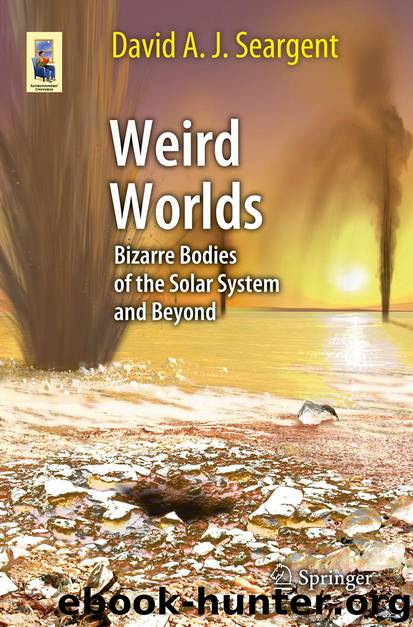Weird Worlds by David A. J. Seargent

Author:David A. J. Seargent
Language: eng
Format: epub
Publisher: Springer New York, New York, NY
Other “Plutos” and Their Siblings
Returning to Kuiper belt objects in general, several groups or families of these have been distinguished according to their orbital characteristics; principally how they relate dynamically to Neptune. Several resonances exist between the orbital periods of Kuiper belt objects and Neptune. Thus, those having periods of around 250 years complete two orbits for every three of Neptune and are said to be in a 2:3 resonance with that planet. Another group, with periods around 275 years has a 3:5 resonance with Neptune, completing three circuits for every five of Neptune. There are other resonances as well; for instance, objects with periods of 290 years are in a 4:7 resonance, those with 330 year periods in a 1:2 resonance and those around 410 years in a 2:5. Pluto, it should be noted, is in a 2:3 resonance with Neptune and therefore becomes the prototype of this family of Kuiper belt objects, not surprisingly known as plutinos. Members of the 1:2 resonance family are also given special names. They are twotinos. Then there are Kuiper belt denizens that are not in any resonance with Neptune at all. These are known as cubewanos.
Whilst speaking of cubewanos, it will be worth mentioning that the largest of their clan thus far discovered—136472 Makemake—appears to develop a transient atmosphere not unlike that observed on Pluto, albeit with a higher concentration of methane relative to nitrogen. This little world was discovered on March 31, 2005 by Michael Brown and evidence for a thin mantle of nitrogen and methane was soon forthcoming. The former gas escapes into space but at the temperature of Makemake (about 30–35 K), methane is not readily lost and therefore accumulates in the thin atmosphere. We will see later that this object—just 444–469 miles (710–750 km) or thereabouts in diameter is nevertheless large enough to join Pluto as another of that special class of minor objects: the dwarf planets (Fig. 3.6).
Fig. 3.6The dwarf planet Makemake as imaged by the Hubble Space Telescope (Credit: NASA/ESA)
Download
This site does not store any files on its server. We only index and link to content provided by other sites. Please contact the content providers to delete copyright contents if any and email us, we'll remove relevant links or contents immediately.
| Aeronautics & Astronautics | Astronomy |
| Astrophysics & Space Science | Comets, Meteors & Asteroids |
| Cosmology | Mars |
| Solar System | Star-Gazing |
| Telescopes | UFOs |
Tools of Titans by Timothy Ferriss(8213)
Turbulence by E. J. Noyes(7935)
Secrets of Antigravity Propulsion: Tesla, UFOs, and Classified Aerospace Technology by Ph.D. Paul A. Laviolette(5309)
Astrophysics for People in a Hurry by Neil DeGrasse Tyson(5130)
Room 212 by Kate Stewart(5035)
Design of Trajectory Optimization Approach for Space Maneuver Vehicle Skip Entry Problems by Runqi Chai & Al Savvaris & Antonios Tsourdos & Senchun Chai(5011)
Pale Blue Dot by Carl Sagan(4907)
The David Icke Guide to the Global Conspiracy (and how to end it) by David Icke(4624)
A Journey Through Divination and Astronomy by Publishing Pottermore(4340)
Goodbye Paradise(3724)
Apollo 8 by Jeffrey Kluger(3635)
COSMOS by Carl Sagan(3553)
Losing the Nobel Prize by Brian Keating(3498)
The Five People You Meet in Heaven by Mitch Albom(3474)
How to Read Water: Clues and Patterns from Puddles to the Sea (Natural Navigation) by Tristan Gooley(3406)
Brief Answers to the Big Questions by Stephen Hawking(3369)
How to Read Nature by Tristan Gooley(3249)
The Order of Time by Carlo Rovelli(3144)
A Brief History of Time by Stephen Hawking(2959)
